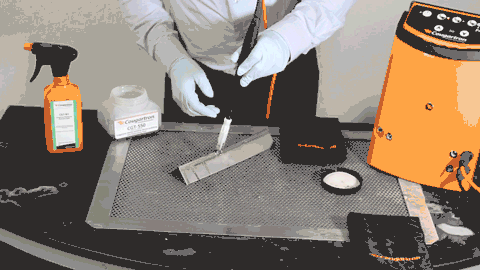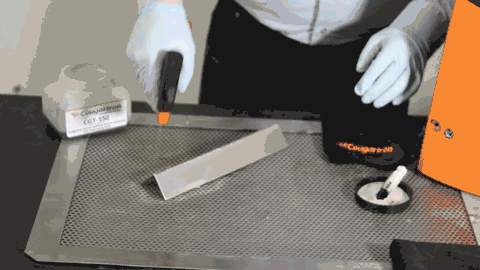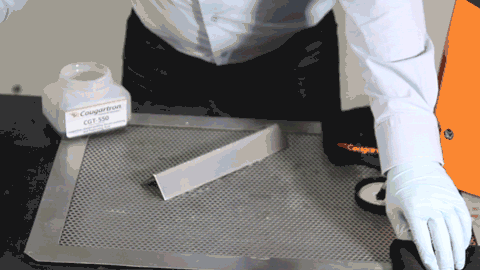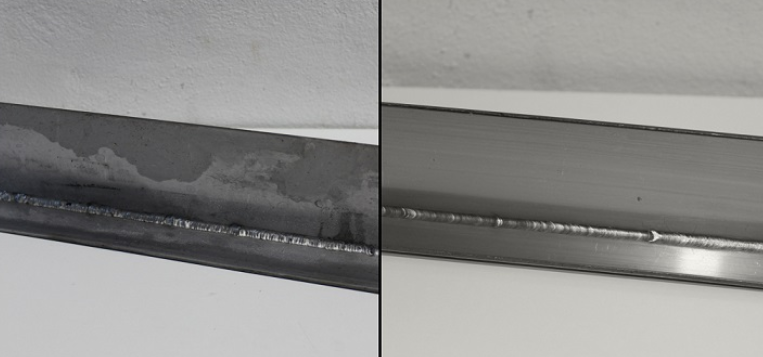Ask Cougartron Part 3: How to neutralize stainless steel welds and surfaces (step-by-step guide).
Weld cleaning | Ask Cougartron | Thursday, 15 March 2018
How to properly neutralize stainless steel after weld cleaning?
Updated on August 2021.
This time we are talking about neutralization – a topic that is often overlooked within the overall weld cleaning process.
The question we received is related to an acid residue that appears on the metal surface after weld cleaning when the neutralization process is not done properly (or at all).
Your question: Why are white acid marks appearing even after the surface was neutralized?
To adequately explain the problem, we must first analyze why neutralization is needed after electrochemical weld cleaning. Then, we’ll provide an overview of the wrong and the correct way to neutralize (stainless steel) welds and surfaces.
What is neutralization?
Electrolytic weld cleaning is done by using phosphorus-based acids which, with the help of electricity, eliminate impurities from stainless steel and other metal surfaces after welding.
Weld cleaning fluids are mild but often result in recognizable white acid marks appearing on the metal surface in the absence of proper neutralization.

However, the white acid residue is only a visible symptom of the real problem – the increased concentration of the acidic substance on the metal surface. This value is most often measured through the pH scale (0-14) with 7 being the neutral point.
There are several important reasons for restoring the acid-neutral state of metal surfaces and welds after the weld cleaning process:
- Cosmetic appearance – white acid marks cover the metal surface making it messy and unappealing which is especially important when talking about metals that are known for their attractive appearance (e.g. stainless steel).
- Legal regulations – In a lot of situations, regulations require that any surface in direct contact with food or water must be acid-free. This also applies to other materials and goods that are susceptible to acidity.
The benefits of the process are numerous but how are stainless steel welds neutralized properly? We discuss the wrong and the right way below.
Neutralization - the wrong way
Neutralization requires the use of specialized neutralizing fluids which are commonly applied to the surface with the help of a sprayer. Plenty of industrial professionals apply the neutralizer immediately after the weld is cleaned with a brush.
So, the process looks something like this:
- Cleaning the weld with a brush and weld cleaning fluid (acid)
- Application of the neutralizing fluid
- Wiping the surface with a cloth
While this process might work in some cases, it does not guarantee that the formation of white stains. When neutralization is done in this manner, there is a possibility that acid will not be completely removed. The amount of neutralizer applied must surpass the amount of acid present on the surface in order for the process to be successful.
Instead, we recommend a more effective method to neutralize stainless steel welds and surfaces.
Neutralization – the right way
The essentials of the process remain almost the same.
The correct neutralization process should thus consist of the following stages:
Step 1:
The weld cleaning brush is used for applying the cleaning liquid to the metal piece and conducting the necessary amount of electricity for successful weld cleaning.
Step 2:
You must wipe away the excess weld cleaning fluid from the surface immediately after weld cleaning so there is less area to neutralize afterwards.

Step 3:
Neutralizing fluids are commonly applied to the surface with the help of a sprayer bottle. In this way, the neutralizer can be evenly distributed over a metal piece. We recommend applying a generous amount of neutralizer.

Step 4:
Wipe the surface again, now with a new clean cloth since the first cloth contains acid residue, and should not be used to wipe away the neutralizing fluid.

TIP: Our CGT-N5 Neutralizer will create bubbles on the surface while it’s reacting with the weld cleaning acid. The bubbles will stop forming once the process is done and this is when it is safe to wipe dry the surface.

Cougartron Neutralizer & Accessories
Loading products...
Please wait while the products load.


 English
English  English (US)
English (US)  German
German  Danish
Danish  Swedish
Swedish  French
French  Polish
Polish  Spanish
Spanish